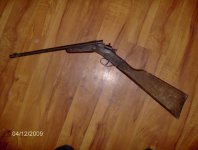Hi, this is my first post but I have spent some time looking around and this looks like a great gun forum with lots of information. That being said I have recently found a small .22 that I guess is a falling or rolling block rifle. It appears to be a youth rifle. The barrel is 15 inches long and with out the butt stock it is 19.25 inches long . It is missing part of the firing mechanism. I am looking for information on what it is and if I can get parts or blueprints for the missing peice or peices. Below are the pictures I hope.




Thanks for any information.
Chris




Thanks for any information.
Chris

